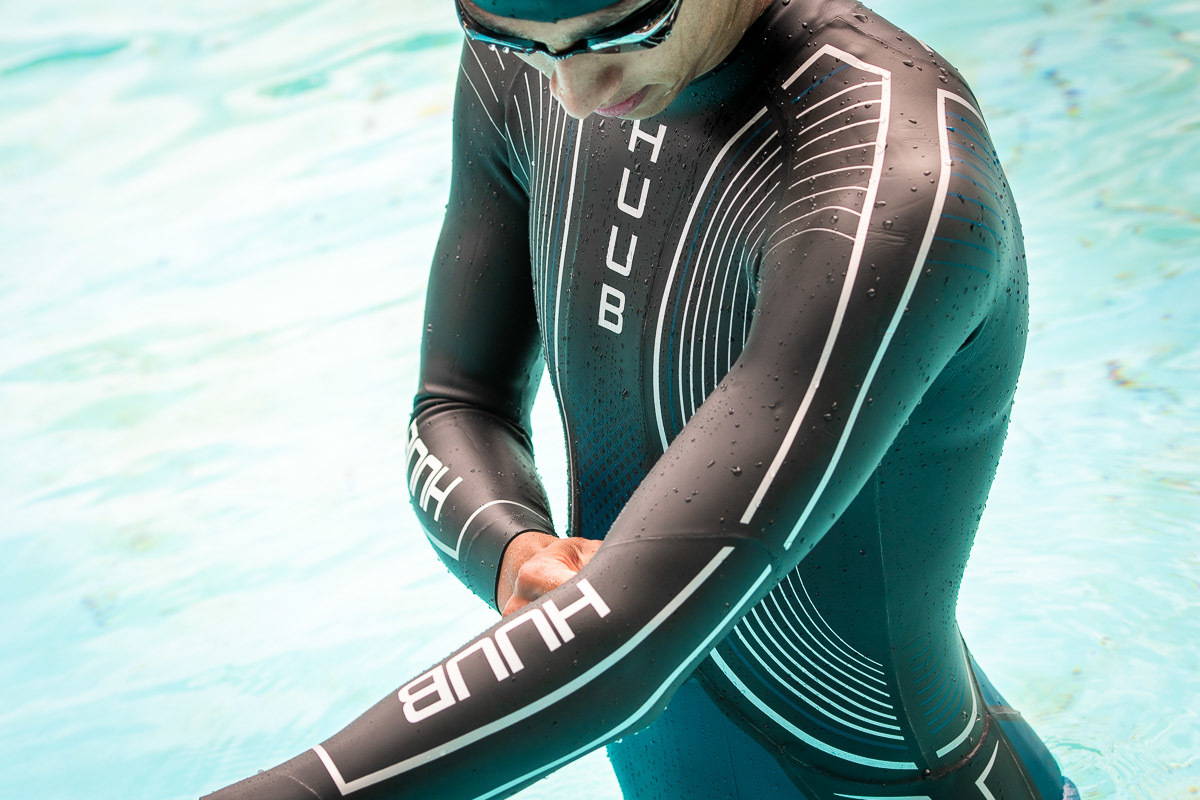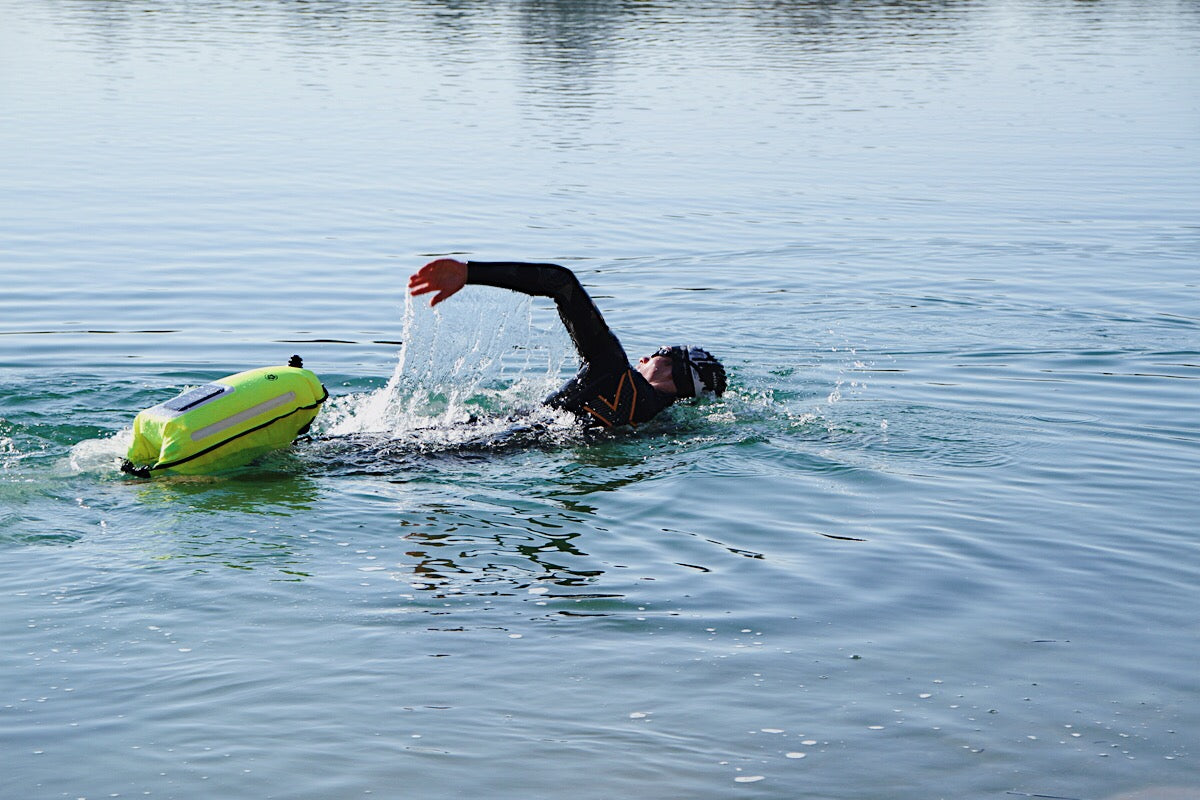Swimming without neo? An unpleasant idea for many - it is so valuable for improving the position in the water and a much more efficient swimming technique. We explain what is behind the technology of fast webbed feet.
RULES
The provisions for using a wetsuit in triathlon can be found in §§20+21 of the sports regulations of the DTU. This is mainly about the properties of a cold protection suit (what is allowed/what is forbidden). However, a pleasant side effect of the protection against the cold is a significantly improved buoyancy and lower friction values when gliding through the wet element.
Chloroprene rubber is hidden behind the brand name "Neoprene" from the DuPont company. In 1932, this US company was the first to market the polymer under the then name Duprene. The material has cold-insulating properties and thus protects triathletes from cooling down in the water.
In the triathlon regulations, the wetsuit is listed as a cold protection suit, but the manufacturers of the wetsuits make sure that their triathlon-specific suits are not described as protection against the cold. The reason: Special rules apply to “cold protection suits” because they have to meet a CE standard, which in turn would result in higher costs.
MATERIAL THICKNESS
The World Triathlon Union (ITU) allows the use of neoprene thicknesses up to a maximum of five millimeters .
Basically, the thicker the neoprene, the more buoyancy and cold protection there is, BUT the less stretchy and elastic the material is.
Most wetsuits therefore use different material thicknesses , as they are composed (sewn/glued) of different individual elements. Wherever good buoyancy properties are required, thicker material can be found: mostly in the hip and thigh area. The "Aerodome Technology" is also used in the models with the highest lift. Small air cells in the material further increase the buoyancy effect in these areas (easily recognizable by the honeycomb structure). In areas of high stretching, the material tends to be thinner (often 1 to 2 millimeters) for greater flexibility. This is especially important in the area of the arms and shoulders.
MATERIAL QUALITY
There are a handful of companies around the world that can use synthetic rubber to produce the right material for the production of triathlon wetsuits. The best-known manufacturer is Yamamoto , whose material is used in most high-quality suits. The numbering provides information about the properties. The higher the number, the softer and more elastic the material. The currently most flexible material is Yamamoto #45.
The difference between the neoprene types lies in the number of trapped nitrogen bubbles created by the foaming of the synthetic rubber. The isolating effect of the nitrogen inclusions protects the suit against the cold on the one hand, and also provides buoyancy in the water on the other. The more gas pockets per unit of space, the more stretchable and flexible the neoprene material is.
The disadvantage of such high-tech materials is the lower resistance to mechanical influences. For this reason, the foamed rubber is laminated with nylon fabric - this is the inner fabric of the wetsuit. It should be noted that the laminate of rubber and textile fabric is responsible for the flexibility of the triathlon wetsuit. So if the inner textile fabric isn't just as stretchy, the most flexible neoprene material is useless.
SURFACE
In the early 1990s, Yamamoto introduced SCS (Super Composite Skin) technology. This special coating reduces the frictional resistance of the neoprene surface.
The Nano SCS coating is now state-of-the-art. This is a further development of the Yamamoto invention in which nano particles on the neoprene surface reduce water resistance even further.
COLOR
Basically, the basic color of a wetsuit is black, which is due to the coloring of the synthetic rubber. During production, it is possible to add dyes. However, this also reduces the stretchability of the neoprene. Many manufacturers still use color for marketing reasons. Another way to color the neoprene is to print color onto the suit. This process is used when applying the logos.
ADDITIONAL FEATURES
Many manufacturers provide their neoprene models with additional material properties in order to optimize them even more specifically for certain aspects of the water position or swimming behavior. For example: so-called "Roll Bars" or "Stability Panels" are reinforcements, mostly in the torso or hip area, which prevent over-rotation and are intended to additionally stabilize the water position. "Forarm Panels", on the other hand, are structural elements on the forearms of some neoprene models with the purpose of improving "water catching" and arm pull. Depending on the design and target group of the wetsuit, various such additional properties are used here. However, the designations for these elements usually vary from manufacturer to manufacturer, since the design and processing are often protected by patents.
THE SECOND SKIN
The interaction of all properties makes the wetsuit what it is: protection against the cold, swimming aid, second skin. Since every athlete has different requirements (e.g. water position, swimming ability) and pursues different goals (frequency of competitions & swimming distance), the wetsuits are designed for different target groups: beginners or advanced? Good or bad water situation? Much or little lift? For short or longer swimming distances?
WHICH NEO IS THE RIGHT ONE?
Find out with the Neotest:




















